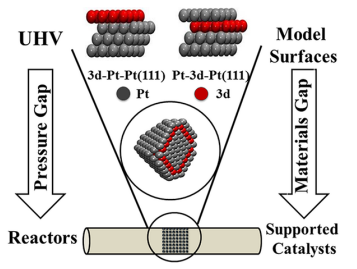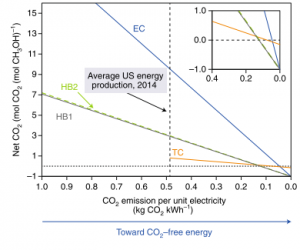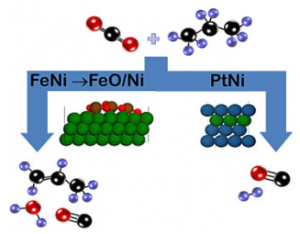Research Approach
The Chen group combines studies on model surfaces and supported catalysts to gain a fundamental understanding of sustainable, industrially-relevant reactions in thermocatalysis and electrocatalysis. Single crystal model surfaces and density functional theory calculations provide insights at the atomic scale. We bridge the “materials gap” using thin film and supported catalysts. We bridge the “pressure gap” using heterogeneous catalysis reactors and electrochemical cells. We focus primarily on bimetallic and carbide catalysts, which often offer advantages of reduced cost and enhanced activity, selectivity, and stability.
 W. Yu, M.D. Porosoff and J.G. Chen, “Review of Pt-based Bimetallic Catalysis: From Model Surfaces to Supported Catalysts”, Chemical Reviews, 112 (2012) 5780-5817.
W. Yu, M.D. Porosoff and J.G. Chen, “Review of Pt-based Bimetallic Catalysis: From Model Surfaces to Supported Catalysts”, Chemical Reviews, 112 (2012) 5780-5817.
Surface Science
Ultra-high vacuum (UHV) conditions are employed to study reactions on well-defined model surfaces. Gas-phase products from a surface reaction on a single crystal or thin film are measured in temperature-programmed desorption (TPD) experiments, and surface intermediates are detected using high-resolution electron energy loss spectroscopy (HREELS). Since ideal surfaces, low temperatures, and vacuum conditions are used during surface science experiments, density functional theory (DFT) calculations are employed to further elucidate reaction mechanisms. The combination of model surface experiments and DFT calculations provide a fundamental understanding of the catalytic system, which is critical to the rational design of active, selective, and stable catalysts. Current surface science studies focus on the upgrading of biomass-derived oxygenates via the selective hydrodeoxygenation (HDO) reaction, which removes undesired oxygen in the molecules.
The first step in the reaction pathway of glycerol selective HDO on a DFT modelled Cu/Mo2C (0001) interface site, which is shown to be selective for ally-alcohol and propanal production, rather than propylene (Mo site) or acetol (Cu site)3.
Recent Publications:
- Z. Lin, W. Wan and J.G. Chen, “1,2-propanediol as a surrogate molecule of glycerol for mechanistic studies of selective hydrodeoxygenation reactions over Mo2C and Cu/Mo2C surfaces”, ACS Sustainable Chemistry & Engineering, 7 (2019) 8077-8082.
- Z. Lin, R. Chen, Z. Qu and J.G. Chen, “Hydrodeoxygenation of biomass-derived oxygenates over metal carbides: From model surfaces to powder catalysts”, (Critical Review), Green Chemistry, 20 (2018) 2679.
- W. Wan, S.C. Ammal, Z. Lin, K.-E. You, A. Heyden and J.G. Chen, “Controlling reaction pathways of selective C-O bond cleavage of glycerol”, Nature Communications, 9 (2018) 4612.
Electrocatalysis
One of the challenges associated with grid-scale implementation of solar and wind energy is intermittency. The electrochemical production of energy-dense molecules provides a means of storing and transporting energy from these intermittent, localized renewable sources. The electrolyzers and fuel cells used for these applications often utilize expensive platinum group metals (PGMs). One focus of the Chen group is to study non-precious materials that can replace or reduce PGM loading and associated costs.
At the lab scale, the Chen group studies PGM-modified transition metal carbide and bimetallic catalysts for a range of electrochemical reactions, including oxygen evolution (OER), hydrogen evolution (HER), CO2 reduction (CO2RR), and ethanol oxidation (EOR).
(Left) DFT calculated binding energies of reaction species can be useful descriptors of experimental activity. In the case of HER catalysts, there is a volcano relationship between the binding energy of hydrogen and the logarithm of the exchange current density, indicative of activity4. (Right) Electrocatalytic (EC) and thermocatalytic (TC) CO2 reduction to methanol has been studied at the laboratory-scale, but an analysis of the net CO2 emissions associated with four case studies indicates that net negative CO2 emissions are most feasible with hybrid EC/TC processes3.
Recent Publications:
- B.M. Tackett, J.H. Lee and J.G. Chen, “Electrochemical Conversion of CO2 to Syngas with Palladium-Based Electrocatalysts”, Accounts of Chemical Research, 53 (2020) 1535-1544.
- J.H. Lee, S. Kattel, Z. Jiang, Z. Xie, S. Yao, B.M. Tackett, W. Xu, N.S. Marinkovic, and J.G. Chen* “Tuning the Activity and Selectivity of Electroreduction of CO2 to Synthesis Gas using Bimetallic Catalysts”, Nature Communications, 10 (2019) 3724.
- B.M. Tackett, E. Gomez and J.G. Chen, “Net reduction of CO2 via its thermocatalytic and electrocatalytic transformation reactions in standard and hybrid processes”, Nature Catalysis, 2 (2019) 381.
- Q. Zhang, Z. Jiang, B.M. Tackett, S.R. Denny, B. Tian, X. Chen, B. Wang and J.G. Chen, “Trends and descriptors of metal-modified transition metal carbides for hydrogen evolution in alkaline electrolyte”, ACS Catalysis, 9 (2019) 2415-2422.
Thermocatalysis
We combine reactor studies and in situ synchrotron techniques to reveal the fundamental mechanisms of reactions over supported catalysts. These studies guide the development of novel catalysts for industrially-relevant processes. Our research on heterogeneous catalysis for CO2 activation employs dual-functional catalysts with high hydrogenation and C=O bond breaking activity. We employ bimetallic and carbide catalysts for CO2 conversion with H2 and alkanes to value-added products, including CO, olefins, and alcohols.
CO2 and propane can react on the FeNi catalyst to form propylene (left) or on PtNi to form syngas (right). In the case of FeNi, an oxide layer of FeO/Ni that forms during the reaction encourages C-H bond breaking. By contrast, the PtNi catalyst has no oxide phase. Color key: carbon = black, oxygen = red, hydrogen = purple, nickel = green, iron = brown, platinum = blue1.
Ceria-supported catalysts were investigated for CO2 reduction by H2. Oxygen exchange occurred with partially reduced CeO2 beyond the surface layers, and metallic Ni admetal modified the exchange mechanism2.
Recent Publications:
- E. Gomez, S. Kattel, B. Yan, S. Yao, P. Liu and J.G. Chen*, “Combining CO2 Reduction with Propane Oxidative Dehydrogenation over Bimetallic Catalysts”, Nature Communications, 9 (2018) 1398.
- L. R. Winter, R. Chen, X. Chen, K. Chang, Z. Liu, S.D. Senanayake and J.G. Chen, “Elucidating the roles of metallic Ni and oxygen vacancies in CO2 hydrogenation over Ni/CeO2 using isotope exchange and in situ measurements”, Applied Catalysis B: Environmental, 245 (2019) 360-366.
- E. Gomez, B. Yan, S. Kattel and J.G. Chen, “Carbon dioxide reduction in tandem with light alkane dehydrogenation”, Nature Reviews Chemistry, (2019) 638-649.
Plasma-Catalysis
Many of the roadblocks to achieving more efficient and sustainable catalytic processes relate to the high pressure and temperature conditions required by these reactions. In addition, several desirable products are thermodynamically favored under mild conditions. Plasma-catalysis is a new approach that employs non-thermal plasma to excite gases in an electric field. This process generates non-equilibrium, hot electrons, which provide the activation energy of reaction without heating the gas. Unconventional reaction pathways involving radicals and vibrationally excited species may be achieved, but the interactions of these species with a catalyst surface remains largely unexplored. We use in situ techniques to study the reaction mechanisms and kinetics of plasma-activated catalytic reactions. Current projects investigate the role of supported metal-oxide catalysts in the plasma-assisted conversion of CO2 and N2.
- L.R. Winter and J.G. Chen, “N2 Fixation by Plasma-Activated Processes”, Joule, 5 (2021) 300-315.
- L.R. Winter, B. Ashford, J. Hong, A.B. Murphy and J.G. Chen, “Identifying Surface Reaction Intermediates in Plasma Catalytic Ammonia Synthesis”, ACS Catalysis, 10 (2020) 14763−14774.





